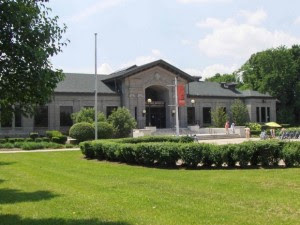Visitors to Chicago’s DuSable Museum of African American History will be inspired by the stories and artistic experiences they find.
The artistic emphasis found in much of the museum is no accident. The museum’s primary founder was the late art teacher and art historian Margaret Burroughs. The museum opened in 1961 in her South Side Chicago mansion as the Ebony Museum of Negro Art and History.
The museum moved in 1973 to its present location at 740 E. 56th Place in Chicago’s Hyde Park neighborhood, just west of the University of Chicago campus, at the edge of Washington Park.
The location already was a part of Chicago’s history, said Jomo Cheatham, who guides visitors as a member of the museum’s education department. The first building, known as the Burnham Wing, is a city landmark designed by Daniel Burnham, a distinguished landscape architect known as the father of Chicago’s park system. Long used as a police administration building, the structure was obtained from the city through a long-term lease the year before the museum opened there. A large addition was added in 1993 as the Washington Wing, a memorial to the late Harold Washington, Chicago’s first African American mayor, and whose stepbrother, Ramon Price, was the museum’s chief curator until his death 15 years ago.
Currently, another Burnham building, formerly used as a stable for horses south of the present museum area, is being renovated as the next addition to the museum complex. As with other major Chicago museums, the land will continue to be owned by the park system.
The museum’s name comes from the first settler who was not a Native American in what became Chicago, a crossroads called Es-chi-ka-gou. That settler was Jean Baptiste Point DuSable, an African-Haitian, who arrived in 1779 and established a trading post that grew into the settlement that eventually grew into a thriving metropolis.
The present museum’s holdings consist of some 150,000 items, including works of art, printed materials and historic artifacts. Visiting exhibits also contribute to the visitor’s experience in what is widely regarded as the nation’s largest museum of African American history.
Visitors enter the museum through the Founders Hall, where eight portraits honor the principal founders. In a prominent location is a sculpture paying tribute to DuSable himself, a rendering of his appearance based upon remaining descriptions rather than an actual portrait, as none exists.
Another gallery displays art from the various African cultures and gives a perspective of the influences that were brought from Africa to the New World.
An especially popular area of the museum is known as “A Slow Walk to Greatness: The Harold Washington Story,” telling about the political life of the city’s first African American mayor.
A recent guest exhibit, “Sixteen Pieces,” consisted of a display of visual art inspired by the sacred literature of the Yoruba people of West Africa. Seventeen paintings created by artists to illuminate the Yoruba divination tradition and interpret verses from the ancient system called Ifa, giving insights into the the Yoruba view of life, death transformation and rebirth.
About 170,000 visitors tour the museum each year, including more than 10,000 public school students last year.

